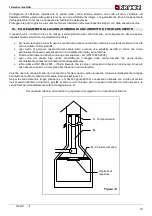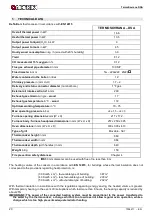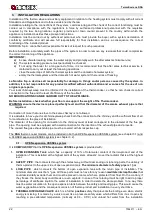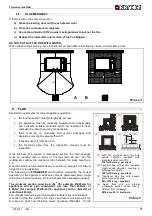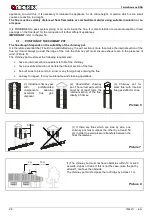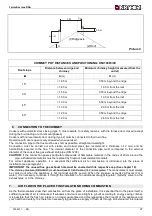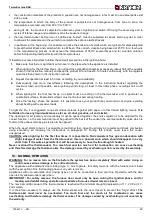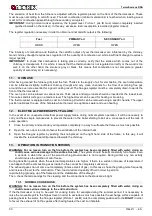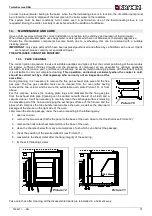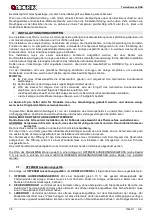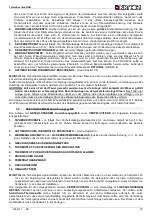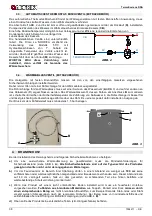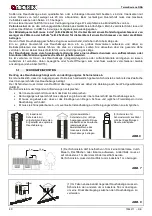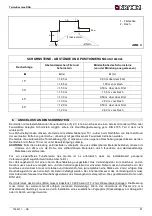
TermoSovrana
DSA
28
7094211 – EN
near the appliance or by placing piping for combustion air which leads outside or to a nearby airy place,
with the
exception of the boiler room or garage (FORBIDDEN).
The connection pipe must be smooth with a minimum diameter of 120 mm. It must have a minimum length of 4 m and
have no more than three bends. If it is directly connected to the outside, it must be equipped with a suitable
windbreak.
The intake of air for combustion in the place of installation must not be obstructed during operation by the
thermocooker. It is absolutely essential that in environments in which thermocookers are operated with a natural
chimney draught, as much air as is necessary for combustion is introduced, i.e. up to 25 m³/hour. The natural
recirculation of air must be guaranteed by some fixed openings to the outside. Their size is established by regulations
regarding the subject. Ask for information from a chimneysweep. The openings must be protected with grills and must
never be blocked up. An extractor hood (suction) installed in the same room or in a neighbouring one causes a
depression in the environment. This causes the leakage of burnt gas (dense smoke, smell); it is therefore necessary
to ensure a greater flow of fresh air.
The depression of an extractor hood can, in the worst case scenario, transform the flue of the thermocooker
into an external air inlet, resucking the flue gases into the environment with very serious consequences for
persons.
8.
PERMITTED/FORBIDDEN FUELS
The permitted fuels are wooden logs. Only dry wooden logs must be used (water content max 20%). The pieces of
wood should have a length of about 30 cm and circumference of 15 - 18 cm max.
The wood used as fuel must have a humidity content lower than 20% which is obtained with a drying time of at least
one year (soft wood) or two years (hard wood) placing it in a dry, airy place (for example under roofing). Damp wood
makes lighting more difficult, as a greater quantity of energy is necessary to make the water present evaporate. The
humidity content also has the disadvantage, as the temperature goes down, of causing the water to condense first in
the furnace and then in the chimney. Fresh wood contains about 60% H
2
O, therefore it is not suitable for burning.
Among other things which cannot be burned: carbon residues, cuttings, bark waste and panels, wood which
is damp or treated with varnishes, plastic materials; in this case, the appliance warranty is forfeited.
Paper and cardboard must only be used for lighting.
The combustion of rubbish is forbidden
and would also
damage the thermocooker and the flue, causing damage to health and, due to the bad smell, causing complaints from
the neighbouring area.
Wood is not a long-lasting fuel and therefore it is not possible to use the thermocooker for continuous heating during
the night.
CAUTION: The continuous and prolonged used of wood which is particularly rich in aromatic oils (e.g.
Eucalyptus, Myrtle etc.) causes the sudden deterioration (flaking) of the cast iron components present in
the product.
* RESINOUS WOOD UNSUITABLE FOR THE THERMOCOOKER
9.
IGNITION
WARNING: For no reason turn on the fire before the system has been completely filled with water; doing so
could cause serious damage to the entire structure
.
IMPORTANT:
during the
first ignition,
it is inevitable that an unpleasant smell is produced (due to the drying of the
adhesives in the sealing cord or the protective varnishes), which disappears after a short use.
The
environment must nevertheless be well ventilated.
On first ignition, we recommend loading a reduced
quantity of fuel and increasing the calorific power of the appliance.
To carry out a correct first ignition of the products treated with varnishes for high temperatures, it is necessary to know
the following information:
Type
Kg/m3
KWh/kg 20% humidity
Beech
750
40
Turkey oak
900
4.2
Elm
640
4.1
Poplar
470
4.1
Larch*
660
4.4
Norway spruce*
450
4.5
Scotch pine*
550
4.4






